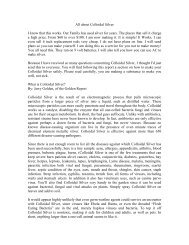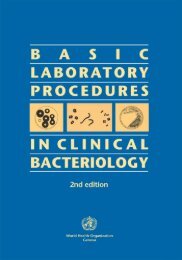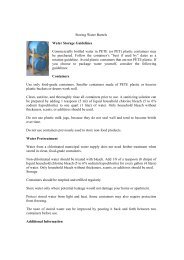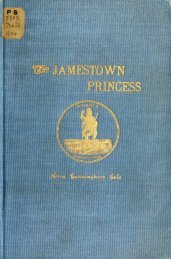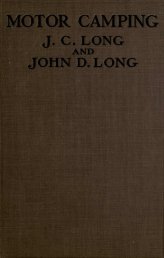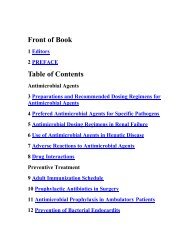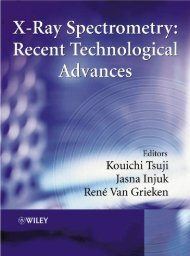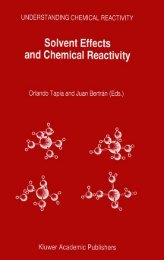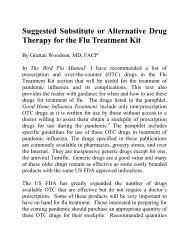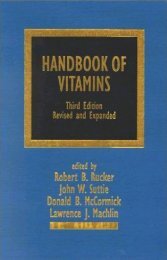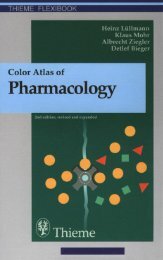Carpenter Ants and Control in Homes - Utah State University ...
Carpenter Ants and Control in Homes - Utah State University ...
Carpenter Ants and Control in Homes - Utah State University ...
You also want an ePaper? Increase the reach of your titles
YUMPU automatically turns print PDFs into web optimized ePapers that Google loves.
<strong>Carpenter</strong> <strong>Ants</strong> <strong>and</strong> <strong>Control</strong> <strong>in</strong> <strong>Homes</strong>Page 1 of 6<strong>Carpenter</strong> <strong>Ants</strong> <strong>and</strong> <strong>Control</strong> <strong>in</strong> <strong>Homes</strong>IntroductionFact Sheet No. 31Revised May 2000Dr. Jay B Karren, Extension EntomologistAlan H. Roe, Insect Diagnostician<strong>Carpenter</strong> ants are members of the <strong>in</strong>sect order Hymenoptera, which <strong>in</strong>cludes bees, wasps,sawflies, <strong>and</strong> other ants. <strong>Carpenter</strong> ants can be occasional pests <strong>in</strong> the home <strong>and</strong> are notedparticularly for the damage they can cause when nest<strong>in</strong>g <strong>in</strong> wood. In <strong>Utah</strong> they are more of anuisance rather than a major structural pest.<strong>Carpenter</strong> ants, along with a number of other ant species, utilize cavities <strong>in</strong> wood,particularly stumps <strong>and</strong> logs <strong>in</strong> decayed condition, as nest<strong>in</strong>g sites. They are most abundant<strong>in</strong> forests <strong>and</strong> can be easily found under loose bark of dead trees, stumps, or fallen logs.Homeowners may br<strong>in</strong>g them <strong>in</strong>to their homes when they transport <strong>in</strong>fested logs from foreststo use as firewood.Description<strong>Carpenter</strong> ants <strong>in</strong>clude species that are among the largest ants found <strong>in</strong> the United <strong>State</strong>s.They are social <strong>in</strong>sects with a complex <strong>and</strong> well-def<strong>in</strong>ed caste system. The worker ants aresterile females <strong>and</strong> may occur <strong>in</strong> different sizes (majors <strong>and</strong> m<strong>in</strong>ors). Members of thereproductive caste (fertile males <strong>and</strong> females) are usually w<strong>in</strong>ged prior to mat<strong>in</strong>g.All ants develop from eggs deposited by a fertilized female (queen). The eggs hatch <strong>in</strong>togrub-like larvae (immatures) which are fed <strong>and</strong> cared for by the workers. When fully grown,the larvae sp<strong>in</strong> a cocoon <strong>and</strong> enter the pupal stage. The pupal stage is a period oftransformation from the larva to adult.<strong>Ants</strong>, <strong>in</strong>clud<strong>in</strong>g carpenter ants, are often mistaken for termites when <strong>in</strong>festations occur <strong>in</strong> oraround homes. These two <strong>in</strong>sects can be dist<strong>in</strong>guished by the follow<strong>in</strong>g differences:1. Antennae - <strong>Ants</strong> have elbowed antennae while termite antennae are straight <strong>and</strong> bead-like.2. Waist - <strong>Ants</strong> have a narrow "waist" area at the front of the abdomen while termites arethick waisted.3. Eyes - Worker ants have compound eyes while termite workers lack these structures.http://extension.usu.edu/<strong>in</strong>sect/fs/carpente.htm6/25/2003
<strong>Carpenter</strong> <strong>Ants</strong> <strong>and</strong> <strong>Control</strong> <strong>in</strong> <strong>Homes</strong>Page 2 of 64. W<strong>in</strong>gs - Both w<strong>in</strong>ged termites <strong>and</strong> w<strong>in</strong>ged ants have two pairs of w<strong>in</strong>gs. In termites thew<strong>in</strong>gs are approximately the same size. In ants the w<strong>in</strong>gs are of unequal length with the frontpair be<strong>in</strong>g much longer than the h<strong>in</strong>d pair.Depend<strong>in</strong>g on species <strong>and</strong> caste, carpenter ant workers are from one-eighth to five-eighths<strong>in</strong>ch <strong>in</strong> length <strong>and</strong> are usually blackish <strong>in</strong> color (with some exceptions). <strong>Carpenter</strong> ants havean evenly rounded thorax (when viewed from the side). Other characteristics <strong>in</strong>clude 12antennal segments, a s<strong>in</strong>gle node (a small-diameter segment) at the front of the abdomen (the"waist"), <strong>and</strong> a circle of hairs around the tip of the abdomen. Other ants may have some ofthese chartacteristics, but not all of them. Any large black ants (about three-eighths <strong>in</strong>ch ormore <strong>in</strong> length) are most likely carpenter ants, but smaller carpenter ants or bicolored speciesare not as easy to recognize.There are 12 species of carpenter ants known to occur <strong>in</strong> <strong>Utah</strong>. Some of these species are allblack or dark brown. Several are bicolored, with portions of their bodies be<strong>in</strong>g black or darkbrown, <strong>and</strong> other areas colored with various shades of red or yellow. Worker ants of thevarious species range <strong>in</strong> size from around 1/4 <strong>in</strong>ch to over 1/3 <strong>in</strong>ch <strong>in</strong> length. The queens arelarger.Biology <strong>and</strong> Habits<strong>Carpenter</strong> ants utilize a wide variety of food sources. Unlike termites, they do not utilize thewood <strong>in</strong> which they tunnel as a food source. They will feed on other <strong>in</strong>sects, relatedarthropods, <strong>and</strong> dead animals. They also feed on honeydew (a sweet liquid secreted by plantfeed<strong>in</strong>g <strong>in</strong>sects such as aphids, mealybugs, scales, <strong>and</strong> treehoppers), plant fluids, <strong>and</strong> varioushousehold food items.Preferred foods of carpenter ants <strong>in</strong>clude honeydew, sweets, <strong>and</strong> <strong>in</strong>sects. <strong>Carpenter</strong> ants arenot especially attracted to prote<strong>in</strong>, oils, seeds, or most plants, although they may feed uponthese occasionally. Regardless of the food source utilized, adult ants <strong>in</strong>gest only liquids orjuices extracted from food materials. The reproductive males <strong>and</strong> females are fed by theworker ants who regurgitate the food material.<strong>Carpenter</strong> ants do not eat wood but will tunnel <strong>in</strong>to wood structures to establish new coloniesor exp<strong>and</strong> exist<strong>in</strong>g ones. They can tunnel <strong>in</strong>to sound lumber but prefer wood that has beensoftened by water <strong>and</strong> rot organisms. Consequently, <strong>in</strong> build<strong>in</strong>gs they often establishthemselves <strong>in</strong>itially <strong>in</strong> w<strong>in</strong>dow sills, door cas<strong>in</strong>gs, thresholds, <strong>and</strong> other areas frequentlysubjected to moisture. Sawdust <strong>and</strong> other debris are cleared from the tunnels <strong>and</strong> dumped <strong>in</strong>piles outside the colony (In contrast, termite tunnels are usually littered with fecal deposits<strong>and</strong> soil).Ant colonies are most noticeable when they swarm. Swarm<strong>in</strong>g is the process of releas<strong>in</strong>g thew<strong>in</strong>ged male <strong>and</strong> female ants <strong>in</strong>to the environment. An ant colony must be well establishedbefore it can produce a swarm. This is because a high <strong>in</strong>put of food <strong>and</strong> labor is required toproduce the w<strong>in</strong>ged reproductive ants. Swarm<strong>in</strong>g is triggered by the right comb<strong>in</strong>ation ofenvironmental conditions, <strong>and</strong> the comb<strong>in</strong>ation differs from one species to another.<strong>Carpenter</strong> ant swarms are usually observed from late spr<strong>in</strong>g to late summer. The presence ofone or two w<strong>in</strong>ged ants <strong>in</strong>doors is not necessarily a sign of an <strong>in</strong>festation, but the source ofhttp://extension.usu.edu/<strong>in</strong>sect/fs/carpente.htm6/25/2003
<strong>Carpenter</strong> <strong>Ants</strong> <strong>and</strong> <strong>Control</strong> <strong>in</strong> <strong>Homes</strong>Page 3 of 6large numbers of w<strong>in</strong>ged ants should be <strong>in</strong>vestigated.<strong>Carpenter</strong> ant colonies can become established <strong>in</strong> a build<strong>in</strong>g either by the <strong>in</strong>vasion of afertilized queen or immigration of an exist<strong>in</strong>g colony. A colony that is established <strong>in</strong> a treestump, buried wood, or any other site may move to a nearby build<strong>in</strong>g if the colony isdisturbed. The colony may also extend its forag<strong>in</strong>g range to <strong>in</strong>clude nearby build<strong>in</strong>gs withoutactually mov<strong>in</strong>g the colony. Therefore, the presence of carpenter ant workers <strong>in</strong> a build<strong>in</strong>gmay not be conclusive proof of an <strong>in</strong>festation. Forag<strong>in</strong>g ranges can be up to several hundredfeet from the actual colony.Inspections <strong>and</strong> SurveysA proper <strong>in</strong>spection is the first step <strong>in</strong> determ<strong>in</strong><strong>in</strong>g a treatment approach to a carpenter antproblem. If carpenter ant workers are found <strong>in</strong>doors dur<strong>in</strong>g w<strong>in</strong>ter or w<strong>in</strong>ged forms emerge<strong>in</strong> the house dur<strong>in</strong>g late w<strong>in</strong>ter <strong>and</strong> spr<strong>in</strong>g, there is probably at least one nest established <strong>in</strong>the structure. If ants occur s<strong>in</strong>gly or are found only <strong>in</strong> mid-summer, the ants may only beforag<strong>in</strong>g from a nest some distance away (or at least not with<strong>in</strong> the structure). The workersize, as mentioned above, can also be used for guidance here.Location of carpenter ant nests is the key to effective control. Inspections for the nests shouldbe carried out both <strong>in</strong>doors <strong>and</strong> outdoors. In the yard, carefully check any tree stumps, deador dy<strong>in</strong>g shrubbery, overhang<strong>in</strong>g tree limbs, <strong>and</strong> attached fences for signs of ant activity.Forag<strong>in</strong>g carpenter ants may enter homes along utility wir<strong>in</strong>g attached to the structure <strong>and</strong>use these wires as "roadways" from an outdoor nest.Outdoor areas of the structure <strong>in</strong>clud<strong>in</strong>g wooden porch floors <strong>and</strong> columns, w<strong>in</strong>dow <strong>and</strong> doorsills, roof edges, <strong>and</strong> areas between the roof <strong>and</strong> the ceil<strong>in</strong>g should be <strong>in</strong>spected carefully forant activity, signs of decay, <strong>and</strong> sawdust. These places are most likely to have wood with ahigh moisture content, or decayed <strong>and</strong> rott<strong>in</strong>g wood, as a result of excessive moisture.Carefully exam<strong>in</strong>e any wood <strong>in</strong> contact with the soil under or aga<strong>in</strong>st the house.Indoors, <strong>in</strong>spect under carpet<strong>in</strong>g, <strong>in</strong> unf<strong>in</strong>ished wood basment areas, <strong>in</strong> closets <strong>and</strong> storagerooms, <strong>in</strong>side electrical boxes, <strong>and</strong> <strong>in</strong> the bottoms of fixed wood cab<strong>in</strong>ets for signs of ants,<strong>in</strong>clud<strong>in</strong>g sawdust. Sawdust may be evident <strong>in</strong> any of these areas <strong>and</strong> may also becometrapped <strong>in</strong> cobwebs <strong>in</strong> basements <strong>and</strong> crawl spaces. If some area of your house is known tohave a moisture or leak problem, <strong>in</strong>spect such areas thoroughly.A thorough <strong>in</strong>door <strong>in</strong>spection should <strong>in</strong>clude exam<strong>in</strong>ation beh<strong>in</strong>d or under <strong>in</strong>sulation <strong>in</strong>attics, wall voids, <strong>and</strong> crawl spaces, where accessible. Pest control professionals may havetools to help <strong>in</strong>spect <strong>in</strong>accessible areas. These tools <strong>in</strong>clude equipment to detect soundsproduced by carpenter ants or other <strong>in</strong>sects, <strong>and</strong> a device called an "Insectascope" that can be<strong>in</strong>serted through a small hole to see <strong>in</strong>side walls or other voids.Forag<strong>in</strong>g carpenter ants can sometimes be followed to determ<strong>in</strong>e the general direction theyare travel<strong>in</strong>g or their po<strong>in</strong>t of entry. These ants may lead you to their nest site. Likewise,workers can be followed from an outdoor nest to determ<strong>in</strong>e if they are enter<strong>in</strong>g the housefrom outdoors. <strong>Carpenter</strong> ants trails are often hidden or covered <strong>and</strong> most forag<strong>in</strong>g activityoccurs at night, so trail<strong>in</strong>g them may not be simple.http://extension.usu.edu/<strong>in</strong>sect/fs/carpente.htm6/25/2003
<strong>Carpenter</strong> <strong>Ants</strong> <strong>and</strong> <strong>Control</strong> <strong>in</strong> <strong>Homes</strong>Page 4 of 6Surveys of carpenter ants can be useful to locate nests or po<strong>in</strong>ts of entry. Index cards dabbedwith honey can be placed <strong>in</strong> various areas <strong>in</strong>clud<strong>in</strong>g w<strong>in</strong>dow sills, near water sources, aroundoutside doors, <strong>and</strong> near open<strong>in</strong>gs where pipes pass through floors or to the outdoors.Depend<strong>in</strong>g on the level of ant activity, the cards can usually be checked after a few hours todeterm<strong>in</strong>e which ones have attracted ants. Survyes <strong>and</strong> <strong>in</strong>spections at night are often moreeffective s<strong>in</strong>ce most forag<strong>in</strong>g activity by carpenter ants occurs at night.If no nests are found <strong>in</strong> the structure or nearby, the nest(s) might be located outside yourproperty. Also, if one nest is found, the possibility of satellite nests exists.Identification Of Species<strong>Carpenter</strong> ants all belong to the genus Camponotus. The identification of carpenter ants tospecies can be important <strong>in</strong> mak<strong>in</strong>g a treatment decision, although this can be difficult forsome worker specimens <strong>and</strong> is impossible for w<strong>in</strong>ged specimens.Certa<strong>in</strong> species, <strong>in</strong>clud<strong>in</strong>g Camponotus modoc, C. herculeanus, <strong>and</strong> C. vic<strong>in</strong>us are morelikely to be structural pests. Other species, <strong>in</strong>clud<strong>in</strong>g C. essigi <strong>and</strong> C. nearcticus are morelikely to be nuisance pests that are not established <strong>in</strong> the structure. Other species, though theyoccur <strong>in</strong> <strong>Utah</strong>, may never be found <strong>in</strong> urban situations.Worker size can be used as an identification tool to some degree. The structural speciesusually have larger workers rang<strong>in</strong>g from about one-fourth to five-eighths <strong>in</strong>ch, whilenuisance species have workers rang<strong>in</strong>g from about one-eighth to one-fourth <strong>in</strong>ch. For the twotypes, the size ranges represent the differences between the major <strong>and</strong> m<strong>in</strong>or castes.<strong>Control</strong>If chemical control becomes necessary there are over 200 <strong>Utah</strong>-registered products labeledfor carpenter ant control <strong>in</strong> <strong>in</strong>door domestic dwell<strong>in</strong>g situations. These <strong>in</strong>secticides come <strong>in</strong>the form of aerosols, baits, dusts, granules, <strong>and</strong> sprays (mixable <strong>and</strong> ready-to-use). Use theone most appropriate for your needs. Active <strong>in</strong>gredients <strong>in</strong> products labeled for this purpose<strong>in</strong>clude abamect<strong>in</strong>, acephate, bendiocarb, bifenthr<strong>in</strong>, boric acid, chlorpyrifos, cyfluthr<strong>in</strong>,cypermethr<strong>in</strong>, D-phenothr<strong>in</strong> plust tetramethr<strong>in</strong>, deltamethr<strong>in</strong>, diaz<strong>in</strong>on, esfenvalerate,fipronil, hydramethylnon, imidacloprid, permethr<strong>in</strong>, propetamphos, propoxur, sulfluramid,synergized pyrethr<strong>in</strong>s, <strong>and</strong> tralomethr<strong>in</strong>.High moisture conditions should be elim<strong>in</strong>ated as an aid to carpenter ant control. Thisprevents future attacks <strong>and</strong> fungus <strong>in</strong>fection. Temporary control of ants <strong>in</strong> homes can beobta<strong>in</strong>ed by spray<strong>in</strong>g them directly with a household aerosol or pump <strong>in</strong>secticideformulations conta<strong>in</strong><strong>in</strong>g one of the follow<strong>in</strong>g active <strong>in</strong>gredients: abamect<strong>in</strong>, acephate,bifenthr<strong>in</strong>, boric acid, chlorpyrifos, cyfluthr<strong>in</strong>, cypermethr<strong>in</strong>, D-phenothr<strong>in</strong> plus tetramethr<strong>in</strong>,diaz<strong>in</strong>on, fipronil, permethr<strong>in</strong>, propoxur, or synergized pyrethr<strong>in</strong>s. Applications should berestricted to surfaces <strong>and</strong> areas listed on the product label. Insecticides should be applied tothe nest <strong>and</strong> nest areas to be most effective. Residual <strong>in</strong>secticides usually are preferred, butthe aerosols of contact <strong>in</strong>secticides are useful <strong>in</strong> flush<strong>in</strong>g out as well as kill<strong>in</strong>g carpenter ants.In most cases eradication of a colony requires the removal or death of the queen(s). Kill<strong>in</strong>ghttp://extension.usu.edu/<strong>in</strong>sect/fs/carpente.htm6/25/2003
<strong>Carpenter</strong> <strong>Ants</strong> <strong>and</strong> <strong>Control</strong> <strong>in</strong> <strong>Homes</strong>Page 5 of 6workers or swarm<strong>in</strong>g ants is generally <strong>in</strong>effective as a healthy queen will soon replace themwith future egg production. S<strong>in</strong>ce the queen does not leave the colony, a method of gett<strong>in</strong>gthe <strong>in</strong>secticide to her <strong>in</strong> the colony must be utilized. The simplest way to do this is to use an<strong>in</strong>secticidal dust or bait.The dust should be lightly applied to areas frequented by forag<strong>in</strong>g workers <strong>and</strong>/or puffed <strong>in</strong>togalleries <strong>in</strong> the wood which are currently be<strong>in</strong>g used by the workers. As the workers moveover the treated surface, the dust will adhere to their bodies <strong>and</strong> be carried back to thecolony. The dust will gradually be spread through the colony <strong>and</strong> may be passed to the queenalong with food. After treatment the ants may seal off treated galleries or stop forag<strong>in</strong>g <strong>in</strong>treated areas. If this happens, additional areas be<strong>in</strong>g used by the workers will have to belocated <strong>and</strong> treated <strong>in</strong> order to obta<strong>in</strong> control. Repeat applications may be required to moveenough dust <strong>in</strong>to the colony to kill the queen. Many dust formulations conta<strong>in</strong><strong>in</strong>g one of thefollow<strong>in</strong>g active <strong>in</strong>gredients may be used <strong>in</strong>doors: bendiocarb, boric acid, chlorpyrifos,cyfluthr<strong>in</strong>, or deltamethr<strong>in</strong>. Follow label directions <strong>and</strong> do not contam<strong>in</strong>ate food, foodprocess<strong>in</strong>g <strong>and</strong> h<strong>and</strong>l<strong>in</strong>g areas, or utensils.Baits should be placed <strong>in</strong> areas where worker activity has been observed. If forag<strong>in</strong>g workersdo not come to the bait with<strong>in</strong> a couple of days, a new location should be baited. Baitformulations conta<strong>in</strong><strong>in</strong>g abamect<strong>in</strong>, boric acid, chlorpyrifos, fipronil, hydramethylnon,propoxur, or sulfluramid are available <strong>in</strong> ant traps. Ant traps are small, capped metal t<strong>in</strong>sfitted with punch-out discs to permit access to the bait by the ants.If repairs are required to correct damage from carpenter ants, it may be possible to remove ortreat the colony (use household aerosol or pump spray formulations listed above) when it isexposed dur<strong>in</strong>g the repair process. Aga<strong>in</strong>, eradication will require that the queen be removedor killed (the queen is w<strong>in</strong>gless at this time <strong>and</strong> the largest ant <strong>in</strong> the colony). If the damagedoes not require repair, control may be obta<strong>in</strong>ed us<strong>in</strong>g the dust or bait formulations. Thema<strong>in</strong> difficulty <strong>in</strong> obta<strong>in</strong><strong>in</strong>g control is locat<strong>in</strong>g the galleries. Consider<strong>in</strong>g that <strong>in</strong>dividualcarpenter ants can live for well over six months without food, it becomes obvious that thegalleries of the nest must be treated. Sometimes it is possible to f<strong>in</strong>d the open<strong>in</strong>gs to thegalleries by look<strong>in</strong>g for the small piles of sawdust-like material the ants push out of thetunnels as they work. It may also be possible to locate the galleries by follow<strong>in</strong>g forag<strong>in</strong>gworkers back to the nest.Precautionary <strong>State</strong>mentAll pesticides have both benefits <strong>and</strong> risks. Benefits can be maximized <strong>and</strong> risks m<strong>in</strong>imizedby read<strong>in</strong>g <strong>and</strong> follow<strong>in</strong>g the label<strong>in</strong>g. Pay close attention to the directions for use <strong>and</strong> theprecautionary statements. The <strong>in</strong>formation on pesticide labels conta<strong>in</strong>s both <strong>in</strong>structions <strong>and</strong>limitations. Pesticide labels are legal documents, <strong>and</strong> it is a violation of both federal <strong>and</strong> statelaws to use a pesticide <strong>in</strong>consistent with its label<strong>in</strong>g. The pesticide applicator is legallyresponsible for proper use. Always read <strong>and</strong> follow the label.http://extension.usu.edu/<strong>in</strong>sect/fs/carpente.htm6/25/2003
<strong>Carpenter</strong> <strong>Ants</strong> <strong>and</strong> <strong>Control</strong> <strong>in</strong> <strong>Homes</strong>Page 6 of 6http://extension.usu.edu/<strong>in</strong>sect/fs/carpente.htm6/25/2003



